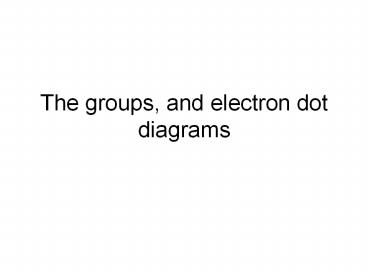The groups, and electron dot diagrams - PowerPoint PPT Presentation
Title:
The groups, and electron dot diagrams
Description:
Each column of the periodic table contains one element family. ... Neon and the elements below it in Group 18 have eight electrons in their outer energy levels. ... – PowerPoint PPT presentation
Number of Views:116
Avg rating:3.0/5.0
Title: The groups, and electron dot diagrams
1
The groups, and electron dot diagrams
2
Why do atoms combine?
1
Element Families
- Elements can be divided into groups, or families.
- Each column of the periodic table contains one
element family.
- Hydrogen is usually considered separately, so the
first element family begins with lithium and
sodium in the first column.
3
Why do atoms combine?
1
Element Families
- Just as human family members often have similar
looks and traits, members of element families
have similar chemical properties because they
have the same number of electrons in their outer
energy levels.
4
Why do atoms combine?
1
Noble Gases
- Neon and the elements below it in Group 18 have
eight electrons in their outer energy levels.
- Their energy levels are stable, so they do not
combine easily with other elements.
5
Why do atoms combine?
1
Noble Gases
- At one time these elements were thought to be
completely unreactive, and therefore became known
as the inert gases.
- When chemists learned that some of these gases
can react, their name was changed to noble gases.
They are still the most stable element group.
6
Why do atoms combine?
1
Halogens
- The elements in Group 17 are called the halogens.
- Fluorine is the most reactive of the halogens
because its outer energy level is closest to the
nucleus.
7
Why do atoms combine?
1
Halogens
- The reactivity of the halogens decreases down the
group as the outer energy levels of each
elements atoms get farther from the nucleus.
8
Why do atoms combine?
1
Alkali Metals
9
Why do atoms combine?
1
Alkali Metals
- The alkali metals form compounds that are similar
to each other.
- Alkali metals each have one outer energy level
electron.
- It is this electron that is removed when alkali
metals react.
- The easier it is to remove an electron, the more
reactive the atom is.
- Unlike halogens, the reactivities of alkali
metals increase down the group.
10
Why do atoms combine?
1
Electron Dot Diagrams
- If you want to see how atoms of one element will
react, it is handy to have an easier way to
represent the atoms and the electrons in their
outer energy levels.
- You can do this with electron dot diagrams.
- An electric dot diagram is the symbol for the
element surrounded by as many dots as there are
electrons in its outer energy level.
11
Why do atoms combine?
1
How to Write Them
- The dots are written in pairs on four sides of
the element symbol.
- Start by writing one dot on the top of the
element symbol, then work your way around adding
dots to the right, bottom, and left.
12
Why do atoms combine?
1
How to Write Them
- Add a fifth dot to the top to make a pair.
Continue in this manner until you reach eight
dots to complete the level.
13
Why do atoms combine?
1
Using Dot Diagrams
- Now that you know how to write electron dot
diagrams for elements, you can use them to show
how atoms bond with each other.
- A chemical bond is the force that holds two atoms
together.
- Atoms bond with other atoms in such a way that
each atom becomes more stable. That is, their
outer energy levels will resemble those of the
noble gases.
14
Section Check
1
Question 1
Electrons are now known to swarm around the
nucleus of an atom in a configuration known as
the _______.
A. electron circle B. electron cloud C. electron
configuration D. electron swarm
15
Section Check
1
Answer
The answer is B. The cloud includes all the
regions where an electron might be found.
16
Section Check
1
Question 2
What information can you learn from this diagram?
17
Section Check
1
Answer
This image is an example of an electron dot
diagram. It tells you that nitrogen contains five
electrons in its outer energy level.
18
Section Check
1
Question 3
The _______ an energy level is from the nucleus,
the _______ electrons it can hold.
A. closer, more B. closer, less C. farther,
less D. farther, more
19
Section Check
1
Answer
The answer is D. The farthest shells contain the
greatest number of electrons.
20
This powerpoint was kindly donated to
www.worldofteaching.com http//www.worldofteac
hing.com is home to over a thousand powerpoints
submitted by teachers. This is a completely free
site and requires no registration. Please visit
and I hope it will help in your teaching.

